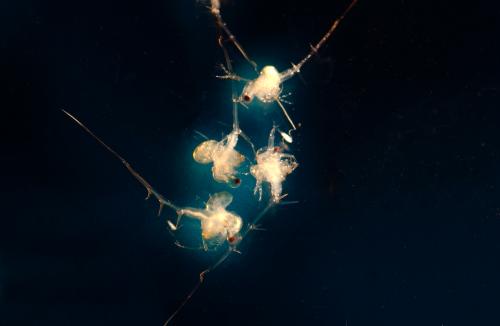Spiny waterfleas are winter survivors
Non-native invasive Spiny waterfleas survive winters with resilient eggs. Their eggs can endure freezing, drought and going through the guts of fish.

The spiny waterflea (Bythotrephes longimanus) is a non-native aquatic invasive species that was first seen in the Great Lakes region in 1982. Since then, it has spread to all the Great Lakes, to many inland lakes, to other states and to Canada. This tiny crustacean is a species of zooplankton that has a preference for large deep lakes with cool bottoms. They sink during the day and rise to the water’s surface at night.
Spiny waterflea adults are about three quarters of an inch long; most of this is their spiny tail. They have a dark eye resembling just a spot on their bodies. They feed on plankton and directly compete with some juvenile fish for similar prey, sometimes outcompeting for the same food source. Larger fish can eat them and are readily consumed by larger fish species. Their eggs are resilient and have been observed to survive winter freezing, drying out, and the passing through the guts of fish. When they accumulate in numbers on fishing lines and nets they look like a gelatinous glob with small black dots and hairs.
Their long spines are not straight and so easily hook onto fishing nets, lines, trawls and other gear. They have become an invasive nuisance to fishing. This is also its primary way of being spread to other lakes and waterbodies. According to the Isle Royal National Park Service, “Research also showed that even after passing through the guts of fish, spiny water flea eggs were intact and viable. Because of this, it is extremely important that fish from one body of water not be released into a different body of water.”

Spread of the Spiny waterflea can be prevented by:
- Inspect and remove any gelatinous and algae materials from fishing lines and nets.
- Prevent the release of fish or plants from one body of water to another.
- Flush bilge water, bait buckets or livewells before you leave a lake for home.
- Clean and dry equipment using a mild chlorine solution.
- Maintain good boat hygiene – Clean Boats, Clean Waters.
For more information about invasive aquatic plants contact me, Beth Clawson, an MSU Extension educator. To learn more about invasive organisms and invasive aquatic plants contact Michigan State University Extension Natural Resources educators who are working across Michigan to provide aquatic invasive species educational programming and assistance. You can contact an educator through MSU Extension’s Find an Expert search tool and searching for the topic: “Water Quality.”



 Print
Print Email
Email




